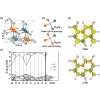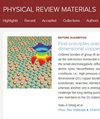Cation disorder in MgSnN2 and its effects on the electronic properties
IF 3.4
3区 材料科学
Q2 MATERIALS SCIENCE, MULTIDISCIPLINARY
引用次数: 0
Abstract
Ternary nitride is a promising candidate to fill the “green gap” of nitride-based light-emitting diodes. The coexistence of two different valence cations offers a unique tunability on its electronic properties through controlling the degree of cation site ordering without a concomitant change in stoichiometry. In this work, the structural and electronic properties of cation-disordered are studied through a combination of density functional theory calculations, cluster expansion, and Monte Carlo simulations. The order-disorder phase transition is analyzed, and the short-range and long-range order parameters quantifying the degree of disorder are calculated. A strong correlation between the two parameters is observed, indicating the absence of the octet-rule-conserving disorder. Cation disorder has two main effects on the electronic properties of . One is the reduction of the band gap, and the other is the strong localization of valence band edge states. Further analysis showed that the localization is a consequence of the weak interatomic coupling between the N atoms and the disorder-induced fluctuation of the local electrostatic potentials on the N atoms. These results could be helpful for the understanding of disorder effects in , as well as the tuning of its properties through the control of cation ordering.

MgSnN2 中的阳离子无序及其对电子特性的影响
三元氮化物 MgSnN2 有望填补氮化物发光二极管的 "绿色空白"。两种不同价位的阳离子共存,通过控制阳离子位点有序化程度,为其电子特性提供了独特的可调谐性,而无需同时改变化学计量学。在这项研究中,我们结合密度泛函理论计算、簇扩展和蒙特卡罗模拟,研究了阳离子失序 MgSnN2 的结构和电子特性。分析了有序-无序相变,并计算了量化无序程度的短程和长程有序参数。观察到这两个参数之间存在很强的相关性,表明不存在八分位守恒无序。阳离子无序对 MgSnN2 的电子特性有两个主要影响。一个是带隙的减小,另一个是价带边缘态的强烈局域化。进一步的分析表明,这种局域化是 N 原子间微弱的原子间耦合和无序引起的 N 原子局部静电势波动的结果。这些结果有助于理解 MgSnN2 中的无序效应,以及通过控制阳离子有序来调整其性质。
本文章由计算机程序翻译,如有差异,请以英文原文为准。
求助全文
约1分钟内获得全文
求助全文
来源期刊

Physical Review Materials
Physics and Astronomy-Physics and Astronomy (miscellaneous)
CiteScore
5.80
自引率
5.90%
发文量
611
期刊介绍:
Physical Review Materials is a new broad-scope international journal for the multidisciplinary community engaged in research on materials. It is intended to fill a gap in the family of existing Physical Review journals that publish materials research. This field has grown rapidly in recent years and is increasingly being carried out in a way that transcends conventional subject boundaries. The journal was created to provide a common publication and reference source to the expanding community of physicists, materials scientists, chemists, engineers, and researchers in related disciplines that carry out high-quality original research in materials. It will share the same commitment to the high quality expected of all APS publications.
 求助内容:
求助内容: 应助结果提醒方式:
应助结果提醒方式:


